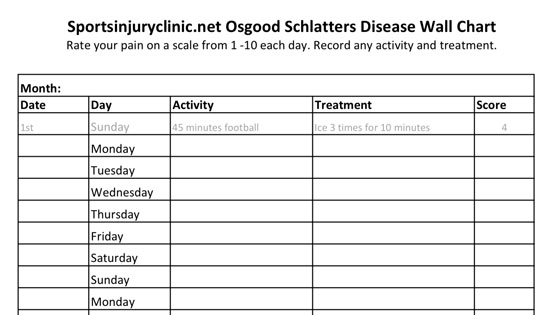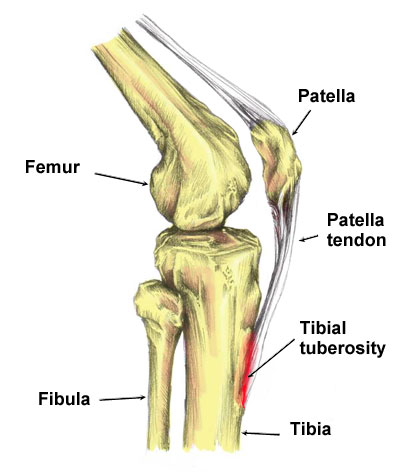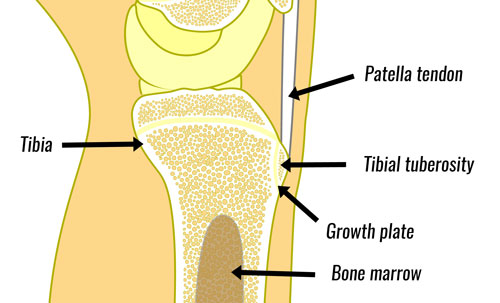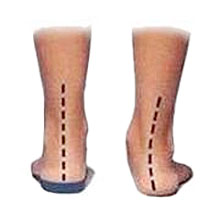Osgood Schlatter Disease causes knee pain in young athletes between the ages of 10 and 15 years. With proper treatment and adapting your training, it can be managed successfully. Our full Osgood Schlatter Disease rehab program takes you step-by-step from initial injury to full fitness.
Medically reviewed by Dr Chaminda Goonetilleke, 21st Dec. 2021
Osgood Schlatter disease symptoms
Osgood Schlatter disease or Osgood Schlatter lesion is a very common cause of knee pain in children between the ages of 10 and 15 years old.
- Knee pain that is localised to a specific point on the front of your shin bone, just below your knee. This bony protrusion is called the tibial tuberosity
- Pain becomes worse with exercise, particularly weight-bearing exercises such as running, football, and sports involving jumping
- You will likely have pain when contracting (tensing) the quadriceps muscles with your leg straight
- Squatting is also likely to be painful, particularly a single-leg squat
Assessment & diagnosis
Osgood Schlatter disease is usually easy to diagnose because of the specific location of symptoms and the age of the patient. A professional therapist will also look for the following signs:
- Your tibial tuberosity may become swollen or inflamed and over time a lump may occur.
- If you have suffered for some time then your quadriceps muscles may have begun to atrophy (waste away).
- In extremely severe cases they may do an X-ray to see exactly how much damage has occurred.
It is possible for Osgood Schlatter disease symptoms to come and go, becoming more or less severe. Often this happens for no apparent reason.
Keep a training diary! You can monitor activity levels and symptoms to identify if any particular training methods worsen your injury.
Download our free symptom tracker

What is Osgood Schlatter disease?
Osgood Schlatter Disease is a painful reaction at the point where the patella tendon inserts into the tibia. This occurs mainly because the bones are not fully developed in children.

The patella tendon (or patella ligament as it is sometimes called) connects the bottom of the kneecap (patella) to the shin bone. It attaches to a bony protrusion called the tibial tuberosity.
Over time it becomes progressively worse as the tendon pulls at the growth plate at the top of the tibia. With repeated trauma, new bone grows back as part of the healing process. This causes an obvious prominent bony lump felt at the tibial tuberosity.
Osgood Schlatter disease was named after two physicians in 1903, Dr. Robert Osgood and Dr. Carl Schlatter.
What causes Osgood Schlatter disease?
Osgood Schlatter syndrome is primarily an overuse injury although certain factors can increase the likelihood of sustaining this condition.
Age
It is more likely to affect boys aged around 13 to 15 years old than girls. However, girls can be affected. If they are though, it is more likely to occur earlier, at about age 10 to 12 years old.
Obviously, this is a general guide and ages can vary. It occurs due to a period of rapid growth, combined with a high level of sporting activity. Osgood Schlatter can occur in adults, however, it is rare. It is more likely if it was not been treated properly during your teenage years.
Growing pains?
As the young athlete’s bones grow quickly, it can take some time for the muscles and tendons to catch up.

If the muscles have not yet adapted to the length of the bones, this can result in additional strain. The additional strain pulls at the point the tendon inserts into the bone. This is frequent in younger athletes because their bones are still soft and are not yet fully grown.
Activity levels
Children who do lots of weight-bearing sports, running, jumping, and football are most at risk. Managing training loads and symptoms is important.
Foot biomechanics

Overpronation is where the foot rolls in or flattens too much when you walk or run. This, in turn, causes the lower leg to rotate in and as a result, the knee. This twisting increases the forces through the patella tendon.
Osgood Schlatter disease treatment
Initial treatment for Osgood Schlatter disease should be to apply the cold therapy PRICE principles of protection, rest, ice, compression, and elevation. Our thigh strain treatment protocol includes:
- Cold therapy & compression
- Taping
- Bracing
- Massage
- Exercises
